
Illustrative Math Alignment: Grade 6 Unit 1
Arithmetic in Base Ten
Lesson 6: Methods for Multiplying Decimals
Use the following Media4Math resources with this Illustrative Math lesson.
| Thumbnail | Title | Description | Curriculum Nodes |
|---|---|---|---|
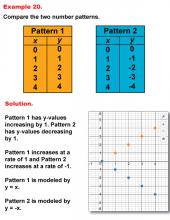
|
Math Example--Numbers--Analyzing Number Patterns--Example 20 | Math Example--Numbers--Analyzing Number Patterns--Example 20Number PatternsNumber Patterns DescriptionThis example demonstrates two number patterns. Pattern 1 has y-values increasing by 1, while Pattern 2 decreases by 1. The graph highlights these variations, modeled by y = x for Pattern 1 and y = -x for Pattern 2. Understanding number patterns is essential in mathematics as it helps students recognize relationships and make predictions. This collection of examples showcases various linear patterns, allowing students to compare different rates of change and their graphical representations. |
Numerical Expressions |

|
Math Example--Numbers--Analyzing Number Patterns--Example 20 | Math Example--Numbers--Analyzing Number Patterns--Example 20Number PatternsNumber Patterns DescriptionThis example demonstrates two number patterns. Pattern 1 has y-values increasing by 1, while Pattern 2 decreases by 1. The graph highlights these variations, modeled by y = x for Pattern 1 and y = -x for Pattern 2. Understanding number patterns is essential in mathematics as it helps students recognize relationships and make predictions. This collection of examples showcases various linear patterns, allowing students to compare different rates of change and their graphical representations. |
Numerical Expressions |

|
Math Example--Numbers--Analyzing Number Patterns--Example 20 | Math Example--Numbers--Analyzing Number Patterns--Example 20Number PatternsNumber Patterns DescriptionThis example demonstrates two number patterns. Pattern 1 has y-values increasing by 1, while Pattern 2 decreases by 1. The graph highlights these variations, modeled by y = x for Pattern 1 and y = -x for Pattern 2. Understanding number patterns is essential in mathematics as it helps students recognize relationships and make predictions. This collection of examples showcases various linear patterns, allowing students to compare different rates of change and their graphical representations. |
Numerical Expressions |
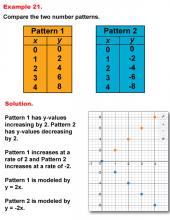
|
Math Example--Numbers--Analyzing Number Patterns--Example 21 | Math Example--Numbers--Analyzing Number Patterns--Example 21Number PatternsNumber Patterns DescriptionThis example features two number patterns. Pattern 1 has y-values increasing by 2, while Pattern 2 decreases by 2. The graph displays these patterns, modeled by y = 2x for Pattern 1 and y = -2x for Pattern 2. Understanding number patterns is essential in mathematics as it helps students recognize relationships and make predictions. This collection of examples showcases various linear patterns, allowing students to compare different rates of change and their graphical representations. |
Numerical Expressions |

|
Math Example--Numbers--Analyzing Number Patterns--Example 21 | Math Example--Numbers--Analyzing Number Patterns--Example 21Number PatternsNumber Patterns DescriptionThis example features two number patterns. Pattern 1 has y-values increasing by 2, while Pattern 2 decreases by 2. The graph displays these patterns, modeled by y = 2x for Pattern 1 and y = -2x for Pattern 2. Understanding number patterns is essential in mathematics as it helps students recognize relationships and make predictions. This collection of examples showcases various linear patterns, allowing students to compare different rates of change and their graphical representations. |
Numerical Expressions |

|
Math Example--Numbers--Analyzing Number Patterns--Example 21 | Math Example--Numbers--Analyzing Number Patterns--Example 21Number PatternsNumber Patterns DescriptionThis example features two number patterns. Pattern 1 has y-values increasing by 2, while Pattern 2 decreases by 2. The graph displays these patterns, modeled by y = 2x for Pattern 1 and y = -2x for Pattern 2. Understanding number patterns is essential in mathematics as it helps students recognize relationships and make predictions. This collection of examples showcases various linear patterns, allowing students to compare different rates of change and their graphical representations. |
Numerical Expressions |

|
Math Example--Numbers--Analyzing Number Patterns--Example 22 | Math Example--Numbers--Analyzing Number Patterns--Example 22Number PatternsNumber Patterns DescriptionThis example compares two number patterns. Pattern 1 has y-values increasing by 3, while Pattern 2 decreases by 3. The graph displays these changes, modeled by y = 3x for Pattern 1 and y = -3x for Pattern 2. Understanding number patterns is essential in mathematics as it helps students recognize relationships and make predictions. This collection of examples showcases various linear patterns, allowing students to compare different rates of change and their graphical representations. |
Numerical Expressions |

|
Math Example--Numbers--Analyzing Number Patterns--Example 22 | Math Example--Numbers--Analyzing Number Patterns--Example 22Number PatternsNumber Patterns DescriptionThis example compares two number patterns. Pattern 1 has y-values increasing by 3, while Pattern 2 decreases by 3. The graph displays these changes, modeled by y = 3x for Pattern 1 and y = -3x for Pattern 2. Understanding number patterns is essential in mathematics as it helps students recognize relationships and make predictions. This collection of examples showcases various linear patterns, allowing students to compare different rates of change and their graphical representations. |
Numerical Expressions |

|
Math Example--Numbers--Analyzing Number Patterns--Example 22 | Math Example--Numbers--Analyzing Number Patterns--Example 22Number PatternsNumber Patterns DescriptionThis example compares two number patterns. Pattern 1 has y-values increasing by 3, while Pattern 2 decreases by 3. The graph displays these changes, modeled by y = 3x for Pattern 1 and y = -3x for Pattern 2. Understanding number patterns is essential in mathematics as it helps students recognize relationships and make predictions. This collection of examples showcases various linear patterns, allowing students to compare different rates of change and their graphical representations. |
Numerical Expressions |
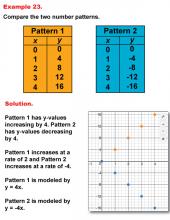
|
Math Example--Numbers--Analyzing Number Patterns--Example 23 | Math Example--Numbers--Analyzing Number Patterns--Example 23Number PatternsNumber Patterns DescriptionThis example compares two number patterns. Pattern 1 has y-values increasing by 4, while Pattern 2 decreases by 4. The graph illustrates these patterns, modeled by y = 4x for Pattern 1 and y = -4x for Pattern 2. Understanding number patterns is essential in mathematics as it helps students recognize relationships and make predictions. This collection of examples showcases various linear patterns, allowing students to compare different rates of change and their graphical representations. |
Numerical Expressions |

|
Math Example--Numbers--Analyzing Number Patterns--Example 23 | Math Example--Numbers--Analyzing Number Patterns--Example 23Number PatternsNumber Patterns DescriptionThis example compares two number patterns. Pattern 1 has y-values increasing by 4, while Pattern 2 decreases by 4. The graph illustrates these patterns, modeled by y = 4x for Pattern 1 and y = -4x for Pattern 2. Understanding number patterns is essential in mathematics as it helps students recognize relationships and make predictions. This collection of examples showcases various linear patterns, allowing students to compare different rates of change and their graphical representations. |
Numerical Expressions |

|
Math Example--Numbers--Analyzing Number Patterns--Example 23 | Math Example--Numbers--Analyzing Number Patterns--Example 23Number PatternsNumber Patterns DescriptionThis example compares two number patterns. Pattern 1 has y-values increasing by 4, while Pattern 2 decreases by 4. The graph illustrates these patterns, modeled by y = 4x for Pattern 1 and y = -4x for Pattern 2. Understanding number patterns is essential in mathematics as it helps students recognize relationships and make predictions. This collection of examples showcases various linear patterns, allowing students to compare different rates of change and their graphical representations. |
Numerical Expressions |
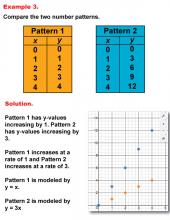
|
Math Example--Numbers--Analyzing Number Patterns--Example 3 | Math Example--Numbers--Analyzing Number Patterns--Example 3Number PatternsNumber Patterns DescriptionThis example focuses on analyzing number patterns. The image displays two tables comparing number patterns identical to Example 2. Pattern 1 has x and y values increasing by 1, modeled by y = x. Pattern 2 has x values increasing by 1 and y values increasing by 3, modeled by y = 3x. A graph depicts these patterns with orange and blue points. |
Numerical Expressions |

|
Math Example--Numbers--Analyzing Number Patterns--Example 3 | Math Example--Numbers--Analyzing Number Patterns--Example 3Number PatternsNumber Patterns DescriptionThis example focuses on analyzing number patterns. The image displays two tables comparing number patterns identical to Example 2. Pattern 1 has x and y values increasing by 1, modeled by y = x. Pattern 2 has x values increasing by 1 and y values increasing by 3, modeled by y = 3x. A graph depicts these patterns with orange and blue points. |
Numerical Expressions |

|
Math Example--Numbers--Analyzing Number Patterns--Example 3 | Math Example--Numbers--Analyzing Number Patterns--Example 3Number PatternsNumber Patterns DescriptionThis example focuses on analyzing number patterns. The image displays two tables comparing number patterns identical to Example 2. Pattern 1 has x and y values increasing by 1, modeled by y = x. Pattern 2 has x values increasing by 1 and y values increasing by 3, modeled by y = 3x. A graph depicts these patterns with orange and blue points. |
Numerical Expressions |
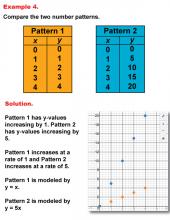
|
Math Example--Numbers--Analyzing Number Patterns--Example 4 | Math Example--Numbers--Analyzing Number Patterns--Example 4Number PatternsNumber Patterns DescriptionThis example illustrates the analysis of number patterns. The image presents a comparison of two number patterns with tables and a graph. Pattern 1 has x and y values increasing by 1, modeled by y = x. Pattern 2 has y values increasing by 5, modeled by y = 5x. The graph plots both patterns. Understanding number patterns is a fundamental skill in mathematics as it helps students recognize relationships and make predictions. This collection of examples showcases various linear patterns, allowing students to compare different rates of change and their graphical representations. |
Numerical Expressions |

|
Math Example--Numbers--Analyzing Number Patterns--Example 4 | Math Example--Numbers--Analyzing Number Patterns--Example 4Number PatternsNumber Patterns DescriptionThis example illustrates the analysis of number patterns. The image presents a comparison of two number patterns with tables and a graph. Pattern 1 has x and y values increasing by 1, modeled by y = x. Pattern 2 has y values increasing by 5, modeled by y = 5x. The graph plots both patterns. Understanding number patterns is a fundamental skill in mathematics as it helps students recognize relationships and make predictions. This collection of examples showcases various linear patterns, allowing students to compare different rates of change and their graphical representations. |
Numerical Expressions |

|
Math Example--Numbers--Analyzing Number Patterns--Example 4 | Math Example--Numbers--Analyzing Number Patterns--Example 4Number PatternsNumber Patterns DescriptionThis example illustrates the analysis of number patterns. The image presents a comparison of two number patterns with tables and a graph. Pattern 1 has x and y values increasing by 1, modeled by y = x. Pattern 2 has y values increasing by 5, modeled by y = 5x. The graph plots both patterns. Understanding number patterns is a fundamental skill in mathematics as it helps students recognize relationships and make predictions. This collection of examples showcases various linear patterns, allowing students to compare different rates of change and their graphical representations. |
Numerical Expressions |
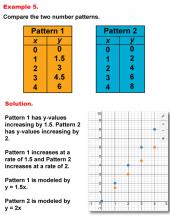
|
Math Example--Numbers--Analyzing Number Patterns--Example 5 | Math Example--Numbers--Analyzing Number Patterns--Example 5Number PatternsNumber Patterns DescriptionThis example demonstrates the analysis of number patterns. The image shows a comparison of two number patterns with tables and a graph. Pattern 1 has x and y values increasing by 1.5, modeled by y = 1.5x. Pattern 2 has y values increasing by 2, modeled by y = 2x. The graph plots both patterns. Analyzing number patterns is a crucial skill in mathematics as it helps students identify relationships and make predictions. This collection of examples presents various linear patterns, enabling students to compare different rates of change and their graphical representations. |
Numerical Expressions |

|
Math Example--Numbers--Analyzing Number Patterns--Example 5 | Math Example--Numbers--Analyzing Number Patterns--Example 5Number PatternsNumber Patterns DescriptionThis example demonstrates the analysis of number patterns. The image shows a comparison of two number patterns with tables and a graph. Pattern 1 has x and y values increasing by 1.5, modeled by y = 1.5x. Pattern 2 has y values increasing by 2, modeled by y = 2x. The graph plots both patterns. Analyzing number patterns is a crucial skill in mathematics as it helps students identify relationships and make predictions. This collection of examples presents various linear patterns, enabling students to compare different rates of change and their graphical representations. |
Numerical Expressions |

|
Math Example--Numbers--Analyzing Number Patterns--Example 5 | Math Example--Numbers--Analyzing Number Patterns--Example 5Number PatternsNumber Patterns DescriptionThis example demonstrates the analysis of number patterns. The image shows a comparison of two number patterns with tables and a graph. Pattern 1 has x and y values increasing by 1.5, modeled by y = 1.5x. Pattern 2 has y values increasing by 2, modeled by y = 2x. The graph plots both patterns. Analyzing number patterns is a crucial skill in mathematics as it helps students identify relationships and make predictions. This collection of examples presents various linear patterns, enabling students to compare different rates of change and their graphical representations. |
Numerical Expressions |
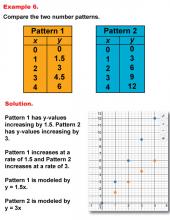
|
Math Example--Numbers--Analyzing Number Patterns--Example 6 | Math Example--Numbers--Analyzing Number Patterns--Example 6Number PatternsNumber Patterns DescriptionThis example focuses on analyzing number patterns. The image presents a comparison of two number patterns with tables and a graph. Pattern 1 has x and y values increasing by 1.5, modeled by y = 1.5x. Pattern 2 has y values increasing by 3, modeled by y = 3x. The graph plots both patterns. Understanding number patterns is a fundamental skill in mathematics as it helps students recognize relationships and make predictions. This collection of examples showcases various linear patterns, allowing students to compare different rates of change and their graphical representations. |
Numerical Expressions |

|
Math Example--Numbers--Analyzing Number Patterns--Example 6 | Math Example--Numbers--Analyzing Number Patterns--Example 6Number PatternsNumber Patterns DescriptionThis example focuses on analyzing number patterns. The image presents a comparison of two number patterns with tables and a graph. Pattern 1 has x and y values increasing by 1.5, modeled by y = 1.5x. Pattern 2 has y values increasing by 3, modeled by y = 3x. The graph plots both patterns. Understanding number patterns is a fundamental skill in mathematics as it helps students recognize relationships and make predictions. This collection of examples showcases various linear patterns, allowing students to compare different rates of change and their graphical representations. |
Numerical Expressions |

|
Math Example--Numbers--Analyzing Number Patterns--Example 6 | Math Example--Numbers--Analyzing Number Patterns--Example 6Number PatternsNumber Patterns DescriptionThis example focuses on analyzing number patterns. The image presents a comparison of two number patterns with tables and a graph. Pattern 1 has x and y values increasing by 1.5, modeled by y = 1.5x. Pattern 2 has y values increasing by 3, modeled by y = 3x. The graph plots both patterns. Understanding number patterns is a fundamental skill in mathematics as it helps students recognize relationships and make predictions. This collection of examples showcases various linear patterns, allowing students to compare different rates of change and their graphical representations. |
Numerical Expressions |
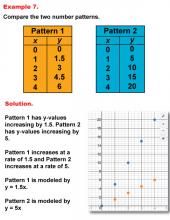
|
Math Example--Numbers--Analyzing Number Patterns--Example 7 | Math Example--Numbers--Analyzing Number Patterns--Example 7Number PatternsNumber Patterns DescriptionThis example illustrates the analysis of number patterns. The image shows two tables comparing number patterns. Pattern 1 has x-values from 0 to 4 with y-values increasing by 1.5. Pattern 2 has x-values from 0 to 4 with y-values increasing by 5. A graph plots both patterns. Analyzing number patterns is a crucial skill in mathematics as it helps students identify relationships and make predictions. This collection of examples presents various linear patterns, enabling students to compare different rates of change and their graphical representations. |
Numerical Expressions |

|
Math Example--Numbers--Analyzing Number Patterns--Example 7 | Math Example--Numbers--Analyzing Number Patterns--Example 7Number PatternsNumber Patterns DescriptionThis example illustrates the analysis of number patterns. The image shows two tables comparing number patterns. Pattern 1 has x-values from 0 to 4 with y-values increasing by 1.5. Pattern 2 has x-values from 0 to 4 with y-values increasing by 5. A graph plots both patterns. Analyzing number patterns is a crucial skill in mathematics as it helps students identify relationships and make predictions. This collection of examples presents various linear patterns, enabling students to compare different rates of change and their graphical representations. |
Numerical Expressions |

|
Math Example--Numbers--Analyzing Number Patterns--Example 7 | Math Example--Numbers--Analyzing Number Patterns--Example 7Number PatternsNumber Patterns DescriptionThis example illustrates the analysis of number patterns. The image shows two tables comparing number patterns. Pattern 1 has x-values from 0 to 4 with y-values increasing by 1.5. Pattern 2 has x-values from 0 to 4 with y-values increasing by 5. A graph plots both patterns. Analyzing number patterns is a crucial skill in mathematics as it helps students identify relationships and make predictions. This collection of examples presents various linear patterns, enabling students to compare different rates of change and their graphical representations. |
Numerical Expressions |
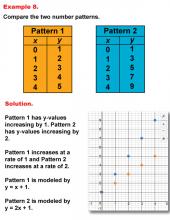
|
Math Example--Numbers--Analyzing Number Patterns--Example 8 | Math Example--Numbers--Analyzing Number Patterns--Example 8Number PatternsNumber Patterns DescriptionThis example demonstrates the analysis of number patterns. The image shows two tables comparing number patterns. Pattern 1 has x-values from 0 to 4 with y-values increasing by 1. Pattern 2 has x-values from 0 to 4 with y-values increasing by 2. A graph plots both patterns. Understanding number patterns is a fundamental skill in mathematics as it helps students recognize relationships and make predictions. This collection of examples showcases various linear patterns, allowing students to compare different rates of change and their graphical representations. |
Numerical Expressions |

|
Math Example--Numbers--Analyzing Number Patterns--Example 8 | Math Example--Numbers--Analyzing Number Patterns--Example 8Number PatternsNumber Patterns DescriptionThis example demonstrates the analysis of number patterns. The image shows two tables comparing number patterns. Pattern 1 has x-values from 0 to 4 with y-values increasing by 1. Pattern 2 has x-values from 0 to 4 with y-values increasing by 2. A graph plots both patterns. Understanding number patterns is a fundamental skill in mathematics as it helps students recognize relationships and make predictions. This collection of examples showcases various linear patterns, allowing students to compare different rates of change and their graphical representations. |
Numerical Expressions |

|
Math Example--Numbers--Analyzing Number Patterns--Example 8 | Math Example--Numbers--Analyzing Number Patterns--Example 8Number PatternsNumber Patterns DescriptionThis example demonstrates the analysis of number patterns. The image shows two tables comparing number patterns. Pattern 1 has x-values from 0 to 4 with y-values increasing by 1. Pattern 2 has x-values from 0 to 4 with y-values increasing by 2. A graph plots both patterns. Understanding number patterns is a fundamental skill in mathematics as it helps students recognize relationships and make predictions. This collection of examples showcases various linear patterns, allowing students to compare different rates of change and their graphical representations. |
Numerical Expressions |
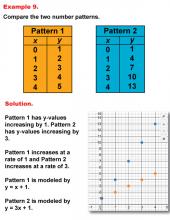
|
Math Example--Numbers--Analyzing Number Patterns--Example 9 | Math Example--Numbers--Analyzing Number Patterns--Example 9Number PatternsNumber Patterns DescriptionThis example presents two different number patterns for analysis. Students can visualize how x-values from 0 to 3 relate to y-values that show different patterns of increments, whether by 1, 2, or 3. With these patterns, students can analyze correlation and differences in rate of increase. Understanding how to interpret these patterns is essential for developing predictive skills in mathematics. |
Numerical Expressions |

|
Math Example--Numbers--Analyzing Number Patterns--Example 9 | Math Example--Numbers--Analyzing Number Patterns--Example 9Number PatternsNumber Patterns DescriptionThis example presents two different number patterns for analysis. Students can visualize how x-values from 0 to 3 relate to y-values that show different patterns of increments, whether by 1, 2, or 3. With these patterns, students can analyze correlation and differences in rate of increase. Understanding how to interpret these patterns is essential for developing predictive skills in mathematics. |
Numerical Expressions |

|
Math Example--Numbers--Analyzing Number Patterns--Example 9 | Math Example--Numbers--Analyzing Number Patterns--Example 9Number PatternsNumber Patterns DescriptionThis example presents two different number patterns for analysis. Students can visualize how x-values from 0 to 3 relate to y-values that show different patterns of increments, whether by 1, 2, or 3. With these patterns, students can analyze correlation and differences in rate of increase. Understanding how to interpret these patterns is essential for developing predictive skills in mathematics. |
Numerical Expressions |
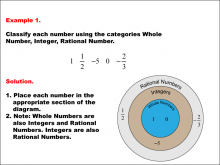
|
Math Example--Numbers--Classifying Numbers--Example 1 | Math Example--Numbers--Classifying Numbers--Example 1
This is part of a collection of math examples that focus on numbers and their properties. |
Numerical Expressions |
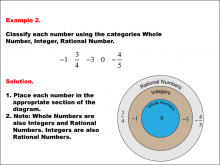
|
Math Example--Numbers--Classifying Numbers--Example 2 | Math Example--Numbers--Classifying Numbers--Example 2
This is part of a collection of math examples that focus on numbers and their properties. |
Numerical Expressions |
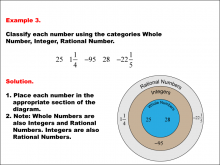
|
Math Example--Numbers--Classifying Numbers--Example 3 | Math Example--Numbers--Classifying Numbers--Example 3
This is part of a collection of math examples that focus on numbers and their properties. |
Numerical Expressions |
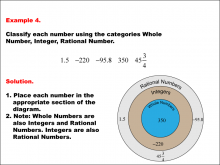
|
Math Example--Numbers--Classifying Numbers--Example 4 | Math Example--Numbers--Classifying Numbers--Example 4
This is part of a collection of math examples that focus on numbers and their properties. |
Numerical Expressions |
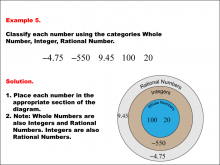
|
Math Example--Numbers--Classifying Numbers--Example 5 | Math Example--Numbers--Classifying Numbers--Example 5
This is part of a collection of math examples that focus on numbers and their properties. |
Numerical Expressions |
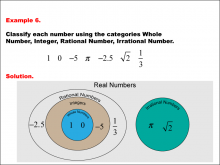
|
Math Example--Numbers--Classifying Numbers--Example 6 | Math Example--Numbers--Classifying Numbers--Example 6
This is part of a collection of math examples that focus on numbers and their properties. |
Numerical Expressions |
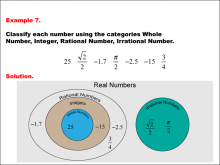
|
Math Example--Numbers--Classifying Numbers--Example 7 | Math Example--Numbers--Classifying Numbers--Example 7
This is part of a collection of math examples that focus on numbers and their properties. |
Numerical Expressions |
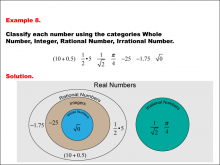
|
Math Example--Numbers--Classifying Numbers--Example 8 | Math Example--Numbers--Classifying Numbers--Example 8
This is part of a collection of math examples that focus on numbers and their properties. |
Numerical Expressions |
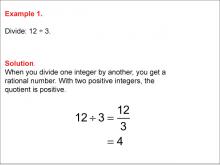
|
Math Example--Numerical Expressions--Dividing Integers: Example 1 | Math Example--Numerical Expressions--Dividing Integers: Example 1TopicNumerical Expressions DescriptionThis example demonstrates the division of two positive integers: 12 divided by 3. The solution shows that when dividing one integer by another, the result is a rational number. In this case, with two positive integers, the quotient is positive. The calculation is presented as 12 ÷ 3 = 12 / 3 = 4. |
Numerical Expressions |

|
Math Example--Numerical Expressions--Dividing Integers: Example 1 | Math Example--Numerical Expressions--Dividing Integers: Example 1TopicNumerical Expressions DescriptionThis example demonstrates the division of two positive integers: 12 divided by 3. The solution shows that when dividing one integer by another, the result is a rational number. In this case, with two positive integers, the quotient is positive. The calculation is presented as 12 ÷ 3 = 12 / 3 = 4. |
Numerical Expressions |

|
Math Example--Numerical Expressions--Dividing Integers: Example 1 | Math Example--Numerical Expressions--Dividing Integers: Example 1TopicNumerical Expressions DescriptionThis example demonstrates the division of two positive integers: 12 divided by 3. The solution shows that when dividing one integer by another, the result is a rational number. In this case, with two positive integers, the quotient is positive. The calculation is presented as 12 ÷ 3 = 12 / 3 = 4. |
Numerical Expressions |

|
Math Example--Numerical Expressions--Dividing Integers: Example 1 | Math Example--Numerical Expressions--Dividing Integers: Example 1TopicNumerical Expressions DescriptionThis example demonstrates the division of two positive integers: 12 divided by 3. The solution shows that when dividing one integer by another, the result is a rational number. In this case, with two positive integers, the quotient is positive. The calculation is presented as 12 ÷ 3 = 12 / 3 = 4. |
Numerical Expressions |

|
Math Example--Numerical Expressions--Dividing Integers: Example 1 | Math Example--Numerical Expressions--Dividing Integers: Example 1TopicNumerical Expressions DescriptionThis example demonstrates the division of two positive integers: 12 divided by 3. The solution shows that when dividing one integer by another, the result is a rational number. In this case, with two positive integers, the quotient is positive. The calculation is presented as 12 ÷ 3 = 12 / 3 = 4. |
Numerical Expressions |

|
Math Example--Numerical Expressions--Dividing Integers: Example 1 | Math Example--Numerical Expressions--Dividing Integers: Example 1TopicNumerical Expressions DescriptionThis example demonstrates the division of two positive integers: 12 divided by 3. The solution shows that when dividing one integer by another, the result is a rational number. In this case, with two positive integers, the quotient is positive. The calculation is presented as 12 ÷ 3 = 12 / 3 = 4. |
Numerical Expressions |

|
Math Example--Numerical Expressions--Dividing Integers: Example 1 | Math Example--Numerical Expressions--Dividing Integers: Example 1TopicNumerical Expressions DescriptionThis example demonstrates the division of two positive integers: 12 divided by 3. The solution shows that when dividing one integer by another, the result is a rational number. In this case, with two positive integers, the quotient is positive. The calculation is presented as 12 ÷ 3 = 12 / 3 = 4. |
Numerical Expressions |

|
Math Example--Numerical Expressions--Dividing Integers: Example 1 | Math Example--Numerical Expressions--Dividing Integers: Example 1TopicNumerical Expressions DescriptionThis example demonstrates the division of two positive integers: 12 divided by 3. The solution shows that when dividing one integer by another, the result is a rational number. In this case, with two positive integers, the quotient is positive. The calculation is presented as 12 ÷ 3 = 12 / 3 = 4. |
Numerical Expressions |
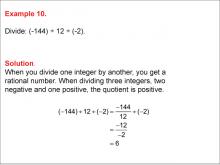
|
Math Example--Numerical Expressions--Dividing Integers: Example 10 | Math Example--Numerical Expressions--Dividing Integers: Example 10TopicNumerical Expressions DescriptionThis example demonstrates the division of three integers: (-144) ÷ 12 ÷ (-2). The solution shows that dividing three integers, two negative and one positive, results in a positive quotient. The calculation is presented step-by-step: (-144) ÷ 12 ÷ (-2) = -12 / -2 = 6. |
Numerical Expressions |